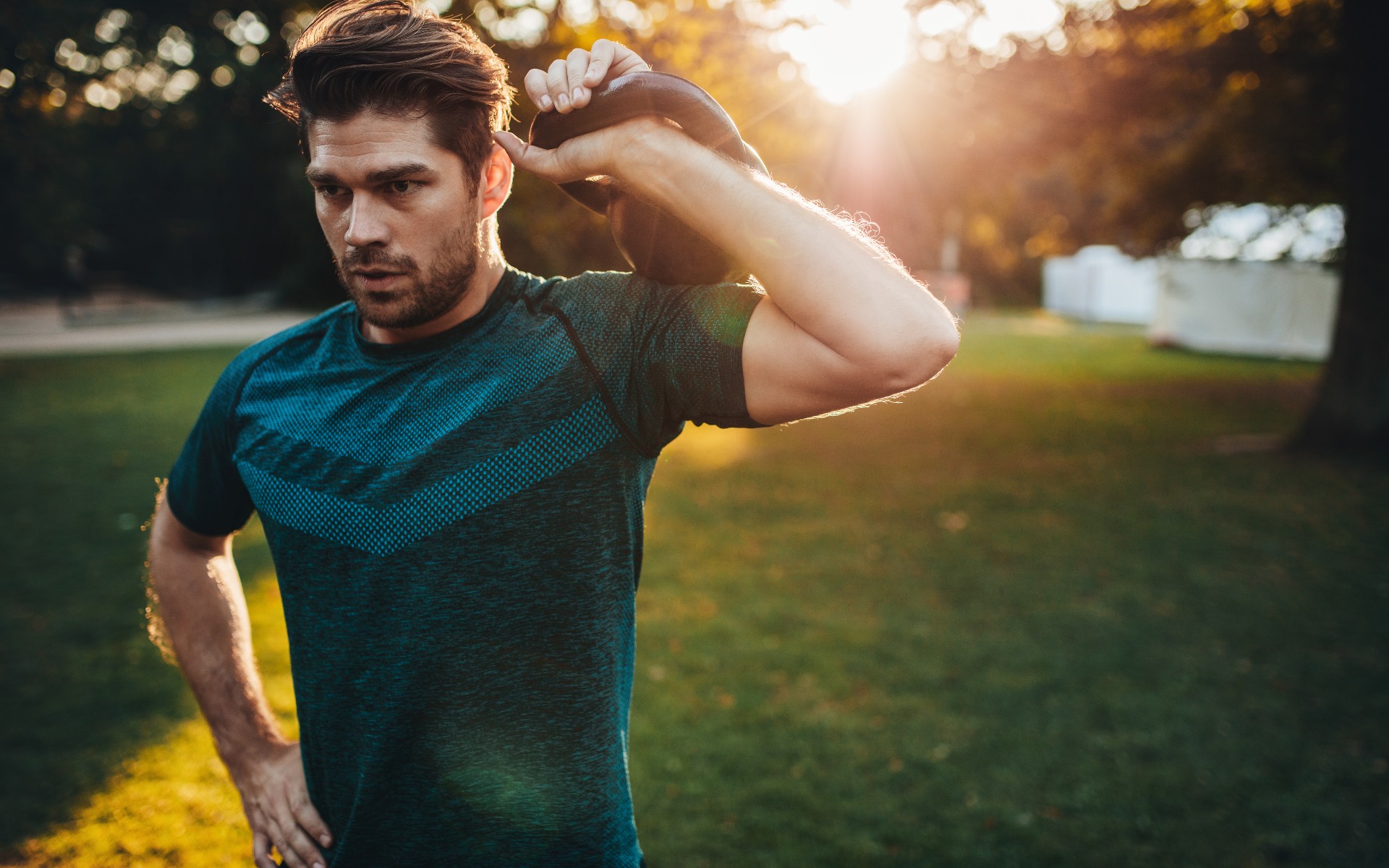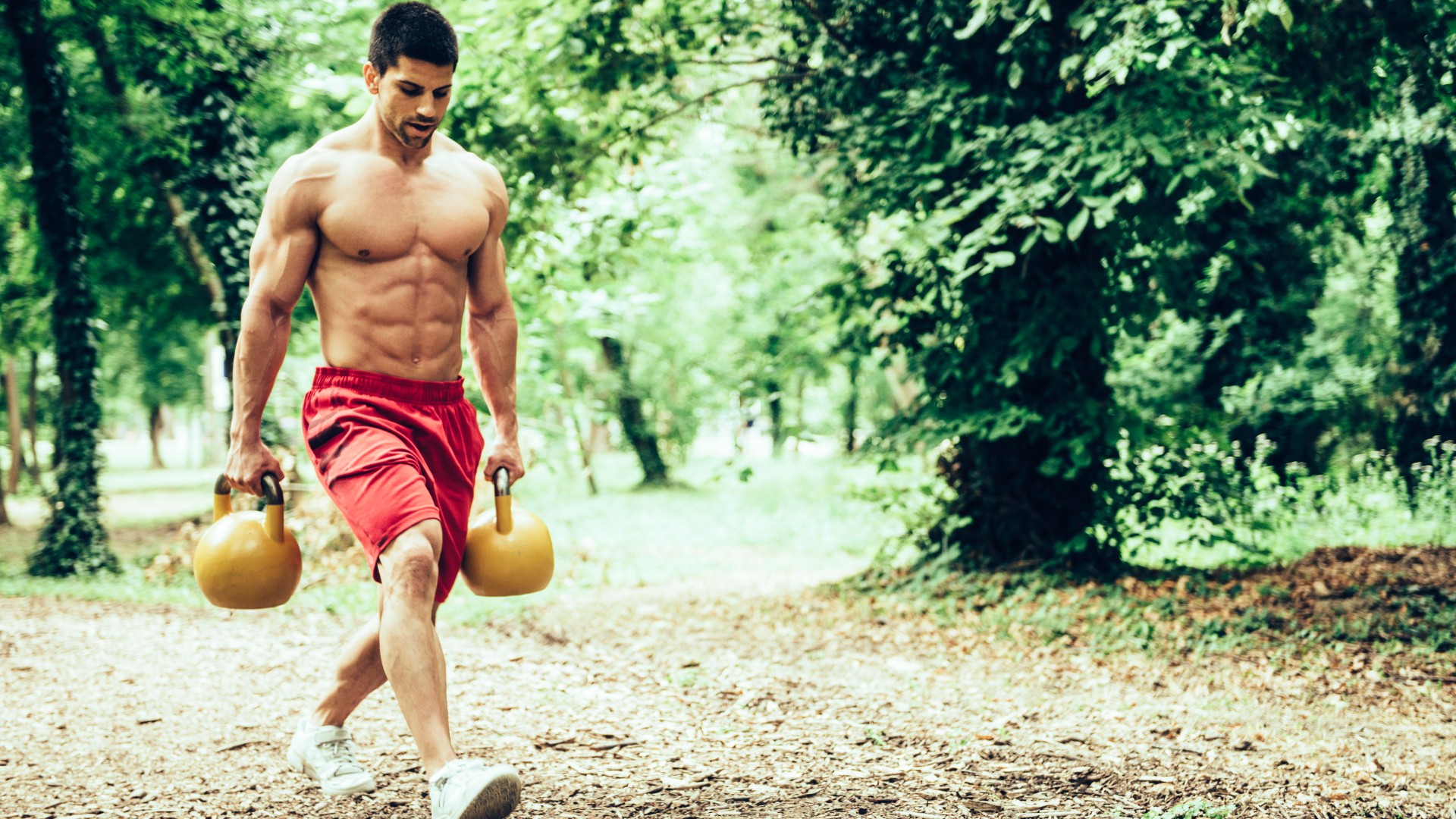
The farmer's carry, also known as the farmer’s walk, simply means walking with weights. In fact, if you’ve carried your groceries home or even held a suitcase for any length of time, you’ve already done it.
The full-body exercise builds strength, stamina and endurance, raises your heart rate and torches your core muscles. So just a few benefits to gain then.
But the offset overhead farmer’s carry is an even more challenging variation on the traditional exercise, which involves adjusting your grip — one arm overhead and the other by your side — and offsetting the load. There are a few pointers to consider beforehand, so we recommend grabbing a dumbbell or one of the best kettlebells for weightlifting and reading on for more.
Offset overhead farmer’s carry: How to do it
Find out how to do the farmer’s walk here if you’re entirely new to the exercise. When we refer to an offset overhead carry, we’re talking about offsetting the load. Try using a set of dumbbells or kettlebells, or even fill some water bottles.
How:
- Stand with your feet hip-width apart and place two kettlebells of different weights on either side of your feet
- Engage your core muscles and keep a flat back as you lift the lighter kettlebell into an overhead position with your elbow locked out
- Grip the heavier kettlebell in the other hand by your side
- Set your shoulders back and down and maintain a tall spine
- Begin walking without leaning forward, backward or over to one side.
Squeeze as many muscles as possible and avoid hunching. Stand tall as you walk.
The lingo on this one can be confusing. Names include the overhead offset carry, kettlebell offset carry, kettlebell overhead offset carry and overhead farmer's carry, to name a few.
Sign up to get the BEST of Tom's Guide direct to your inbox.
Get instant access to breaking news, the hottest reviews, great deals and helpful tips.
Offset just refers to the variation in weights. So if you can't adopt an overhead position, try racking one kettlebell into a clean position at your chest and keep one down by your side, or try a suitcase carry instead (walking with one weight using one arm).

Offset overhead farmer's carry: Benefits
The strength and conditioning exercise is popular within the CrossFit and functional training communities. It’s a compound exercise that resembles walking or climbing with weight, improving movement quality, posture and strength and building muscle using a combination of isometric and isotonic exercise.
That means some muscles, like your shoulders and core, stay active without shortening or lengthening (isometric contraction), while others — your legs — move (isotonic contraction). The offset farmer’s carry hits every muscle group and builds strength in the wrists and forearms, but offsetting the load makes things more interesting (and by that, we mean difficult).
By holding the lighter weight overhead in the more challenging carry position and the heavier weight at your side, the varying resistances test balance, coordination and stabilization and recruit the smaller muscles to keep your upper body stable and upright. Walking with weights overhead also requires even more core and shoulder control and good posture, especially when your opposing arm is down by your side.
And the more you offset the weights, the harder the exercise becomes, even without technically adding more load overall.
Offset overhead farmer's carry: Common mistakes
These are the most common mistakes we see.
Hunching
Internal shoulder rotation is the fastest way to cause an injury, as well as tight chest muscles and weaker, strained back muscles. Many rotator cuff injuries occur from improper shoulder positioning, and these crucial stabilizer muscles support your shoulder joint, so they need to be in tip-top form.
Keep both shoulder blades retracted and reset your posture whenever you notice hunching. Avoid lifting your shoulders toward your ears, and keep the overhead arm stacked with the wrist over the shoulder and close to the ear.
Leaning
Sure, offsetting the weight will cause the body to lean. The load is uneven, after all. But that’s the whole point — your body must work far harder to maintain proper posture and positioning and prevent leaning. Keep your spine tall and avoid leaning forward, back or over to one side. We recommend no more than a 50% less than the heavier weight to start.
Starting too heavy
When you misjudge the offset, you could compromise your form. If you can’t stand up straight or maintain the position for more than a few meters, reduce the difference between the weights or overall volume. Build slowly on each set until you find weights that suit you.
Offset overhead farmer's carry: Variations to try
As the exercise is already a variation of the farmer’s walk, we’ll discuss ways to scale it.
Dumbbells vs kettlebells
Kettlebells take some getting used to. Unlike dumbbells, the bell sits below the handle rather than attaching to either side, making it harder to control. Start with dumbbells, then progress to kettlebells after some practice. We cover how to hold a kettlebell properly here and some grips to try.
Reduce the offset
As mentioned above, choosing drastically different weights could overwork the body, so find what works best for you. The weight should feel challenging to balance, and the overall load should be heavy enough that the last few reps or sets are tough to complete.
Adapt your variables
Once you get the hang of the offset farmer’s carry, try graduating to ascending or descending stairs or a hill. Measure a set number of steps as reps or measure a distance to walk if you have space. A popular CrossFit programming technique involves hitting a set distance against a time cap, but you could also superset or giant set the carry with another exercise.
For example: Complete a 30-second offset farmer’s carry, then 20 bodyweight squats. Repeat, reducing the squats by 2 reps per round until you hit 0.
Interested in hearing more about the farmer’s walk? I did the farmer’s walk every day for a week — here’s what happened.
More from Tom's Guide

Sam Hopes is a level 3 qualified trainer, level 2 reiki practitioner and senior fitness writer at Tom's Guide. She is also currently undertaking her Yoga For Athletes training course. Sam has written for various fitness brands and websites over the years and has experience across brands at Future such as Live Science, Fit&Well, Coach, and T3.
Having worked with fitness studios like F45 and Virgin Active, Sam now primarily teaches outdoor bootcamps, bodyweight, calisthenics and kettlebells. She also coaches mobility and stretching-focused classes several times a week and believes that true strength comes from a holistic approach to training your body.
Sam has completed two mixed doubles Hyrox competitions in London and the Netherlands and finished her first doubles attempt in 1:11.
